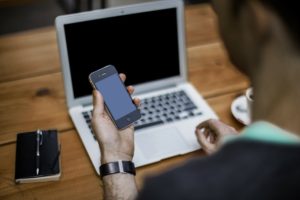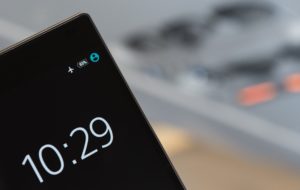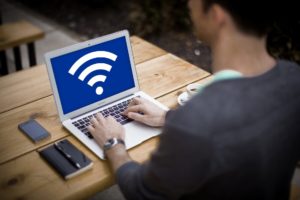Here we show you how items that may be within reach in your own home could be used to create well-produced video resources.
Before hitting record
Storage
Be mindful of how much space is on your recording device. If your device doesn’t have enough space, you risk not being able to successfully save your recordings to use later.
Also, consider the storage capacity of your method for sending your recordings to your computer. For instance, with Voice Memos on iPhones, one method of sending them is via the Mail app. There could be an issue if you have a file that’s longer than 14 minutes, as this is the maximum limit of a sent file.
Whilst you will be able to chop down your recordings to send via Mail, there may be alternative methods you’ll want to use instead. Using Dropbox to send your recordings to your computer is a potential solution. It has more space and syncs changes made to files quickly. You could also use OneDrive and Files (on Apple devices).

Airplane mode
When using your smartphone (either for video or audio resources), make sure that airplane mode is enabled to prevent any notifications from other apps on your device disrupting the recording.
For example, if you receive a phone call, the recording will pause. This could affect the quality of the recording when trying to continue your recording later.

Network connection
Recording using an internet application, such as Zoom, means you are reliant on an internet connection.
This is also true if you are planning on using your phone as your webcam, as your computer and your phone need to be on the same Wi-Fi network to work.
If you are recording on your smartphone, use the camera app (without it being used as a webcam) so you are not reliant on the network connection. To clarify, you will only need a connection later when you are uploading to your computer.

Location
This is important for either video or audio resources. The eLearning team already has a page related to this topic: Video Basics.
For video resources, record somewhere with minimal background distractions to ensure more focus on the content you are making.
Record your audio in a quiet space when outdoor noise is minimal. This could be during the morning or the night, depending on where you are.
Try to record in a smaller space with sound-absorbing materials. These materials include curtains, pillows, quilts and mattresses. While spaces with these materials are likely bedrooms, you could move some of these materials to a different space to create another area for recording.

Recording equipment
Cameras
The eLearning team already have a page related to this topic: Video resources. The Training and Guides section has advice on how to shoot from your smartphone.
If you are working with a computer/laptop with no built-in webcam, using your smartphone could be a solution for you. It’s also useful if you think the resolution from your webcam isn’t as good as you would like it to be. See below a video explaining how to enable a phone as a webcam by installing the Iriun app. The video demonstrates the full installation process.
Sharing your device screen
Screen sharing can allow devices to be used as whiteboards, or to demonstrate apps.
Zoom mobile app
Note for students: Media Services recommend using your student email to sign up for Zoom (on desktop and app) as you will have an upgraded account. Therefore, you will gain some extra settings and capabilities in Zoom.
There are two ways this app can be used:
- Start a meeting: This is for when you want to run your meeting on your iOS or Android device.
- Join your meeting as a participant: This is for when you want to run your meeting from your computer but annotate what you are sharing on your desktop with your iOS or Android.
Below is a video demonstrating how to wirelessly share your screen to Zoom. The demonstration includes both Apple and Android devices.
On Android devices, there are some extra requirements for sharing your smartphone audio:
- Android 10 or higher
- Granted Zoom permission to record when prompted
- Sounds from shared apps must be allowed to be shared with non-system apps. Some apps may not allow this due to security or privacy reasons.
Screen mirroring (iOS only)
On iOS devices, you cannot use the above method to annotate when sharing your entire screen in a meeting with these devices.
The method below works if you want to use the audio and webcam from your computer but also share a whiteboard, or annotate on a presentation.
- Here are instructions on how to use screen mirroring and how to use a wired connection (this connection is only possible on a Mac).
- You can also look at these instructions for how to do this via Airplay.
The video below elaborates on Zoom’s screen sharing capabilities, and how to share the screens of Apple devices.
Lighting
We have another page on some ‘quick wins‘ for recording video resources, including advice on how to improve lighting.
Lighting has a huge impact on video resources. See below a video on how lighting works and some cheap tricks for a good set-up with household items (and even an open Word document on your monitor)!
Outdoor lighting
One of the many challenges of filming resources outside is controlling the light.
To tackle this, you can use bounce-boards. They help redirect some light, giving you more control of the scene. Whilst these can be bought, the video below shows you how can easily create a bounce-board with just a white t-shirt and something rigid (e.g. cardboard boxes).
The weather outside will affect the natural lighting you are working with. The video below offers suggestions on how to make the most of lighting on an overcast day, which includes bringing a mirror with you (not just to monitor your appearance).
The techniques for filming on overcast days do not necessarily apply to sunny days. The video below gives tips on filming in hard sunlight.
Microphones
Gaming headsets
Gaming headsets often have microphones attached, and you may be able to plug these into your phone/PC to improve the standard of your audio capture.
However, if using these headsets, note that the microphone is very close to your mouth, which can lead to popping sounds in your audio, or unclear audio. You may need to test the positioning of the microphone to see what works best.
Smartphones as recorders
Using a smartphone as your microphone offers flexibility in your recording location, particularly if you are not planning to video-record yourself.
Consider testing the audio recording in different rooms with different materials, to find the best location.
Below is an informative video from the BBC YouTube Channel on using your smartphone to record audio. It offers some advice on microphone positioning, as well as sending audio to other devices. The demonstration uses an iPhone, with the built-in app, Voice Memos. You can also look at Apple Store information for the Voice Memos app.
Android devices have a built-in voice recording app. Try Google Support and Verizon for further details. These websites also offer advice on alternative apps you can download if you find the in-built app is not sufficient, and how to transfer your recording to your computer.
The video below advises on how to record professional audio using smartphones, including information on how locations can affect recordings.
Tripods
While recording, your device will need to be propped up and properly angled. Tripods can be useful to position your device without relying solely on the stability of your own/someone else’s hands. However, you don’t have to purchase a tripod to use one. Below you will find some guides on how to make your own.
Gift cards and more
Got a gift card that you still haven’t thrown out? You could use it to make a makeshift tripod! The video below explains how you can easily modify a gift card using a pen for marking and a pair of scissors. It also includes other ideas for homemade tripods.
Rubber bands
You can even equip the likes of a bottle with some rubber bands to make a tripod, which can be placed on top of a pile of books to keep your smartphone at eye level. Similarly, hangers with rubber bands and pens can create one. Watch the video below which shows how both can be done.
Lego®
If you have children in your home, chances are they have Lego®. Or maybe you have some? In any case, they can create a tripod/stand for your device. Watch the video below to see how to make a Lego® tripod.
It is also worth mentioning the value of getting a pile of books and putting your device on top of those. This is an easy way to get the best position/angle for recording.
Shock mounts
If you are recording with a phone/microphone that is lying on your desk, you could find that when you click through your slides or use desk items, it could end up on your recording.
Of course, most disturbances to audio can be edited out in post-processing using simple audio editing or software like Audacity. However, considering this before recording could make the editing process less strenuous.
The video below demonstrates this potential issue, and how some household items can be utilised to create a ‘shock mount’.
Branding resources
This relates to the visual identity of resources being made, including colour palettes, logos, and recommended typography.
The visual identity page for the University could be a good starting point when considering how you want your resources to look.
Branding can increase the professionalism, and thus the quality, of a resource.

